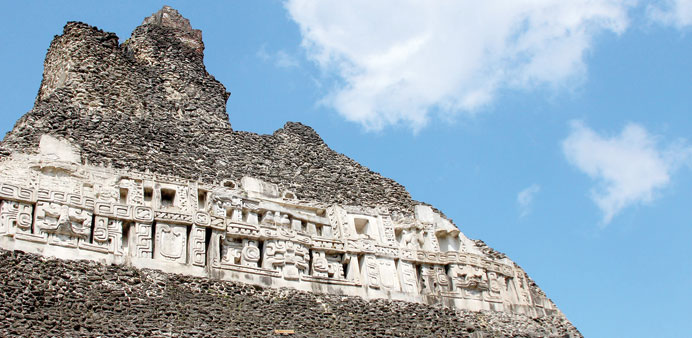Mayan glory days echo at elegant Xunantunich ruins, writes Ellen Creager
Xunantunich is not as famous as Mexico’s Chichen Itza. It’s not as tall as Guatemala’s Tikal.
But here in western Belize, the Xunantunich Mayan ruins will make your jaw drop.
And maybe your palms sweat.
Pronounced shoe-NAN-to-nitch (or as some tourists mangle it, Tuna Sandwich) its name means stone maiden. The dominant structure, El Castillo, is notable not only for its elegant friezes of hieroglyphs depicting rulers and gods, but for the fact that visitors can still climb to the top of the 130-foot temple, if they dare.
Unlike at Mexico’s Chichen Itza, which was closed to climbers in 2006 after a woman fell to her death, Xunantunich’s climb is done in bits and pieces, with plenty of flat places to stop — and even a handrail staircase for the final descent.
Still, it’s not for everyone.
“I’m afraid of heights,” one tour guide confessed as he stood in the shade on a plaza halfway up, watching the rest of his group ascend to the very top. “The view is still good from here.”
Reachable independently by car or as a day-trip excursion for cruise ships docked in Belize City, Xunantunich is one of Belize’s top attractions, although many Americans have never heard of it.
The entrance near the village of San Jose Succotz is surrounded by small shopping kiosks selling crafts and textiles. From there, every person, vehicle and animal must cross the Mopan River on a hand-cranked ferry to enter the park. Then it is a 1-mile uphill trudge to the visitor’s plaza (or a swift ride in a mini-bus, highly recommended in this humid climate where the average temperature is 31C.)
From there, you walk a bit farther, past a gift shop, a brand new visitors’ centre that opened March 21, groves of allspice trees, then onto a grass-covered plaza and the humbling sight of El Castillo.
In Xunantunich’s heyday, roughly 600 to 900AD, “the walls would have been whitewashed plaster and almost certainly painted,” says Jason Yaeger, University of Texas at San Antonio professor of anthropology, who has spent every summer for 23 years in and around Xunantunich. The site spreads out with 26 structures and multiple plazas, many still uncovered.
In terms of importance, “It is a middle-sized site, not as big as (Guatemala’s) Tikal certainly, but at certain times in its history, it was the capital of an autonomous kingdom.”
Although many people think Mayan culture was restricted to what is now Mexico, the grand kingdoms of the first millennium spread throughout what is now Mexico, Belize, Guatemala, El Salvador and Honduras.
Xunantunich just became a tourist attraction in the early 1990s as excavations progressed and tourism infrastructure was added. Today it draws about 46,000 visitors a year.
I found that the special beauty of Xunantunich was compounded by its setting in Belize’s western Cayo District.
This region of rolling hills and rivers looks a lot like Pennsylvania, except with monkeys. It seemed somehow familiar. Relaxing. Some researchers believe Xunantunich was more of a royal ritual getaway, like a country place to escape the nasty politics back in the city. I can see that. I could live here.
From the top of El Castillo, one can kick back and look out at gorgeous vistas for 360 degrees. Problems? What problems?
Of course, the site and region do have reminders of the sometimes cruel world of the Maya. There’s a ball court, where the loser of the games faced sudden death — literally. Not far from Xunantunich is a mysterious cave that was important for Mayan ritual and human sacrifice.
Yaeger says it is worth spending extra time in the region to see not only Xunantunich and other ruins, but also Actun Tunichil Muknal (in English, Cave of the Crystal Sepulchre), thought by the ancient Maya to be an entrance to the underworld. The cave was rediscovered in 1989.
“It’s an all-day adventure tourism trip,” he says. “You hike through jungle and swim a river to get to a cave, then walk through an underground stream for a quarter-mile, then climb into a giant chamber where the Maya left offerings. Sacrificial victims, food offerings, skulls, they are still there on the altars, left where the Maya placed them,” he says. “And you see a small niche where a woman was sacrificed 1,200 years ago, and there are (sparkling calcite) crystals all over her bones.”
After that, a climb to the top of Xunantunich’s El Castillo will seem simple. — Detroit Free Press/MCT

TOWERING: Xunantunich, a grand Mayan ruin in the rolling countryside of western Belize’s Cayo District, had its heyday around 600-850AD. The main stru
